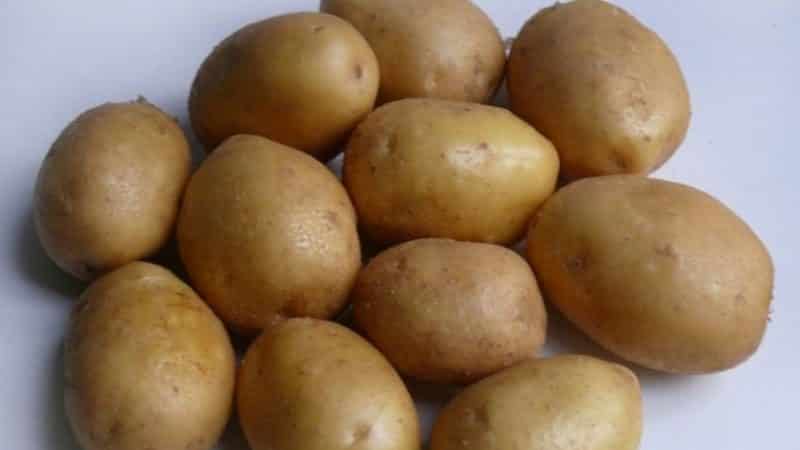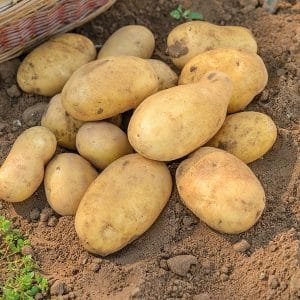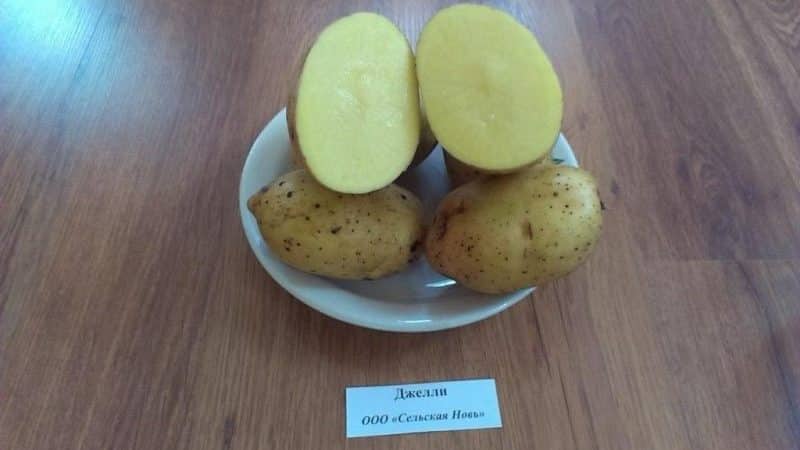The ideal potato variety to purchase for the winter: “Jellie”
Potatoes are a popular and sought-after vegetable in the market. Therefore, he also has many varieties. For those who plan to preserve their potato harvest for a long time, Jelly would be a good option. In addition, it is unpretentious in care and produces a stable harvest.
Let's consider a detailed description of the Jelly potato variety with photos, the growing process and storage features.
Description
Jelly is a mid-early table variety with high yield. The ripening period is 90-110 days from the moment of emergence. The creators of the variety are German breeders. It was included in the Russian state register in 2005.

What is the difference from other varieties
The culture is distinguished by tall, erect bushes, sometimes semi-spreading. Bright green foliage with wavy edges grows on a few stems. During flowering, large white flowers appear. In their place, small quantities of green berries set and ripen.
Chemical composition, trace elements, vitamins
Potato tubers contain proteins, carbohydrates, fiber, pectin, mono- and oligosaccharides, vitamins (almost the entire vitamin B complex) and mineral salts. In addition, the vegetable serves as a source of starch. In the Jelly variety, its share is 14-18%. Potassium and phosphorus salts predominate among the minerals in potatoes.
Characteristics of tubers and yield
The tubers of the Jelly potato are oval-shaped, the eyes are shallow, the skin is rough to the touch, and yellow in color.The pulp also has a yellowish tint. The weight of a ripe tuber is 85-135 g.
Up to 15 potatoes are harvested from one bush. On an industrial scale, the yield per 1 ha is 200-300 c. In the garden with 1 sq. m dig up to 4.5 kg of potatoes.
Important! The Jelly variety is capable of maintaining commercial quality for a long time. Seed potatoes can be successfully stored for several seasons.
Region for cultivation and planting dates
The variety is intended for cultivation in the Central and Volga-Vyatka regions. It is also grown in other regions with temperate and warm climates.
Deadlines landings depend on the specific region. Usually planted in May, but more accurately it can be calculated according to the principle when the soil warms up to +8...+10°C, to a depth of 12 cm.
Advantages and disadvantages of the variety

Jelly potatoes have the following positive characteristics:
- excellent taste and aroma;
- high, stable yield;
- uniformity of tubers in shape and size;
- possibility of long-term storage and good transportability;
- drought resistance;
- unpretentiousness to growing conditions;
- good response to the application of fertilizing and fertilizers;
- immunity to certain diseases and pest attacks;
- the possibility of growing both on an industrial scale and in private summer cottages.
The disadvantage is that Jelly's tubers are dense and contain a small amount of starch, so making mashed potatoes from such potatoes is problematic.
Features of planting and growing
The procedure for planting and growing is not much different from other varieties. But there are some peculiarities.
Preparation
Potato seeds for planting are prepared approximately 4-6 weeks in advance. First, they are kept in the sun for 7-8 days.At this time, poisonous solanine is formed in the seeds, which promotes better resistance to diseases and pests.
The potatoes are then placed in boxes or containers and placed in a warm, dark place to germinate. After about 3-4 weeks, sprouts appear.
Important! Large tubers can be cut into several parts, but so that each part has at least one eye. In addition, to prevent the putrefactive process after cutting, they are kept for 6-7 days until coarsened tissue forms at the cut site.
Before planting, seeds are soaked in a solution of potassium permanganate for disinfection. You can also treat seed potatoes with a growth stimulator.
Planting scheme and technology
It is preferable to plant Jelly potatoes in areas where the snow melts first.
Advice. Before planting, do not forget to dig deep into the soil to remove all remnants of last year's plants. This will reduce the likelihood of developing new diseases.
For potatoes, it is better to select places where beets, cabbage, cucumbers or greens used to grow.
The planting pattern is traditional. The procedure is as follows:
- Dig holes or furrows 8-12 cm deep.
- A little humus and ash are added to each hole, as well as onion peels to repel pests.
- Fresh manure should not be used to fertilize holes. It contains fungal spores and plant seeds, so the potatoes will hurt and lose their taste. But you can use Kemira - a complex fertilizer.
- The seeds are placed at a distance of 40 cm from each other, since the bushes grow powerful and need a lot of space. Leave about 80 cm between rows.
Features of cultivation
Potato plantings need to be harrowed in the first days, even if there are no shoots.This way weeds are destroyed and they hatch faster.

After the first shoots appear, the soil around them is loosened to remove the crust that has formed. This enriches the soil with oxygen, which is necessary for the development of the potato root system.
If planted early, frost may occur. But you can protect the seedlings by hilling up young shoots. Don't be afraid to cover them with soil, this way they will be better protected from the cold.
To save the plantings from drought and waterlogging, the soil is covered with mulch. And proper planting of green manure between rows of potatoes makes caring for the crop much easier. Mustard repels wireworms, and phacelia supplies the roots with the necessary nutrition.
To obtain a good harvest, loosening and hilling the soil around the potatoes is important. This provides the roots with oxygen and helps get rid of weeds.
Nuances of care
The Jelly variety is unpretentious; basic agrotechnical procedures are enough for it.
Watering mode
Water the potatoes systematically according to the following scheme:
- Do not water until the tops appear.
- Water for the first time when the bush is 10-25 cm high.
- The second time is when buds begin to form.
- Water the third time before the end of flowering.
In a very dry region or in very hot and dry summers, the amount of watering can be increased, but stopped after flowering has ended.
Top dressing
During the growing season, Jelly potatoes are fed three times:
- at the beginning – with nitrogen fertilizers;
- when buds and flowers appear, use fertilizers with potassium;
- during the formation of tubers - phosphorus compounds;
Attention! You cannot overfeed the culture. This affects the taste and changes the duration of tuber ripening.
Disease and pest control
The variety has good resistance to many potato diseases. Jelly is not affected by:
- potato cancer;
- rhizoctoniasis;
- common scab;
- blackleg;
- viral diseases.
The only disease that affects Jelly potatoes is late blight. The disease most often develops in waterlogged soil.
If signs of disease appear (spots on the leaves), the plant must be treated with Arcedil, Ridomil MC, Oksikhom, copper oxychloride or Kuproxat.
Important! You can spray potatoes with any preparations only 30 days before harvest.
As for pests, Jelly is resistant to the golden nematode, but is attacked by the Colorado potato beetle and wireworm. You can get rid of them with the help of chemicals, which are used strictly according to the instructions. “Bankol” or “Aktara” are suitable for fighting the beetle.
Difficulties in growing
There are some negative aspects when growing this variety:
- defeat of Jelly potatoes by late blight;
- the need for frequent loosening and hilling of plantings;
- intolerance of tubers even to minor mechanical damage.
Harvest and storage

The harvest begins in September. It is better to do this in clear weather.
How and when to collect
The signal for harvesting is yellowed potato leaves. It is carried out as follows:
- Tubers are dug up using forks, and on large areas - with combines.
- The dug up potatoes are dried in a dry, dark room so that the peel on them becomes stronger.
- Then the potatoes are sorted, removing rotten and green ones.
Important! Greened tubers can be stored until spring and then used as seed.
Storage features and keeping quality of the variety
Jelly potatoes are stored in the basement or cellar.Keep it in bags, nets or boxes. The temperature should be +2…+3°С. At higher rates, the potatoes will begin to sprout.
The keeping quality of the variety is 86%. Many summer residents have noticed that 90% of the harvest harvested in the fall remains in good condition until spring.
Advice from experienced gardeners and reviews about the Jelly variety
Many summer residents who grew the Jelly variety on their plot note the excellent taste of the potatoes, as well as a stable, large harvest. But some people didn't like that the Jelly tubers were hard and bad are boiling over.
Evgeniy, Nizhnekamsk: “The variety is not bad, the yield is high. But I personally don’t like hard and poorly cooked tubers.”
Ruslan, Saransk: “Jellie pleased me with its excellent taste. However, some bushes have been affected by late blight, so I advise you to plant it in dry places with deep groundwater.”
Marina, Salavat: “Even though the variety is called productive, I would argue with that. But as far as care, storage and keeping quality are concerned, this is a solid five. It's great for winter storage."
Read also:
Is it possible to eat potatoes if you have high cholesterol?
Limonka potato variety: description, characteristics and reviews.
Young but promising German potato variety “Krona”: description and reviews.
Conclusion
Jelly is one of the productive potato varieties with proper care and implementation of the necessary agrotechnical measures. Good keeping quality and presentation make it a favorite of many farmers and large agricultural producers.